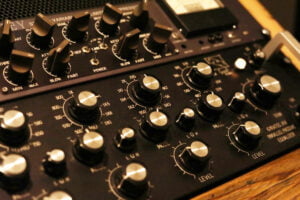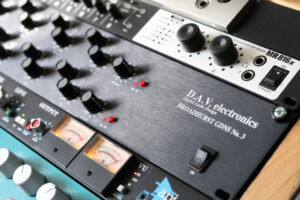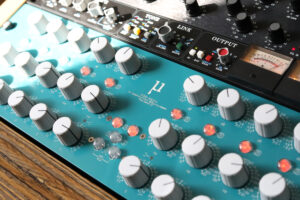The API 2500 stereo bus compressor is a modern classic. While broadly based on the famous SSL G-series mix bus compressor, it is a far more capable beast, with a distinctive tone. A standard fixture on drum buses, its flexibility makes it an extraordinary tool for mastering, as well as for the mix bus.
What does the API 2500 sound like?
As a stereo VCA compressor, the API 2500 is clean, fast, and tight, similar to other SSL-type bus compressors. But thanks to its feedback/feedforward topology, knee controls, and patented API thrust controls, the API 2500 goes much deeper than its cousins.
In feedforward mode it is spiky and authoritative, clamping down on transients as quickly as a limiter and releasing just as fast. If you want audible squash, this is how you get it. In feedback mode (usually preferred for mix buses and mastering) it is much smoother – still offering admirable transient control while gracefully thickening the signal.
Using the thrust control (more on that below) emphasises different areas of the frequency spectrum, making the API 2500 excellent for shaping the overall tone of the track. In mastering, I often find myself shaping the overall groove of the track with the API 2500 before using the Manley Vari-Mu to apply a coat of final glue and polish at the end of the chain.
Part of the appeal of the API 2500 though is its boxtone. The classic API op-amps, along with its transformers, impart a beautiful bite and colour that is difficult to describe. It’s common to run audio through the unit without compressing at all, just to add a bit of that classic API crunch – like seasoning with pepper.
Why is the API 2500 useful?
In short, the API 2500 is useful because it can perform the role of so many other one-trick compressors. Its raft of unusual controls make it as flexible as a plugin, but with the immediacy of button-pushing (as opposed to sub-menu clicking), and the inimitable tone of real analogue circuits, op-amps, and transformers.
For a lot of mix engineers, the API 2500 lives exclusively on their drum bus. For me, I like to use it on my master fader when mixing, shaping the overall tone and rhythm. And I use it in mastering to reign in transients, add some bite, and shape the groove. I often find it’s the API 2500 that does the most to make a track sound ‘like a record.’
Feedback/feedforward
One of the most fundamental aspects of how a compressor behaves is whether it operates in feedback or feedforward.
Feedforward is roughly how you expect a compressor to behave, and how your stock DAW compressor plugin probably works. Signal comes in, compressor acts on it, signal comes out. Everything works as expected. But it can be a little less than forgiving, as all those millisecond controls really happen exactly as you set them.
Feedback works a little differently. Rather than act on the input of the compressor, it acts on the output. This introduces a bit of a delay, meaning it tends to act slower, letting more transients through and releasing a little more gracefully. It also means if you turn the output knob up, your threshold is going to change. Feedback operation tends to be describe as more ‘musical’ than feedforward, often sounding more natural and less squashed, while having a desirable thickening effect.
The API 2500 is fairly unique among analogue compressors in being able to switch between the two at the push of a button.
API patented thrust control
Perhaps the star of the API 2500 show is the API patented thrust control, offering three options ‘loud’, ‘med’, and ‘norm’.
In truth, all its doing is inserting pre-set filters into the sidechain, meaning the compressor is reacting to a filtered signal rather than the actual track. Inserting a high pass filter to stop a compressor acting so heavily on the kick or the bass is common practice now, but it wasn’t so usual when the API 2500 was released.
And a simple high pass filter is not what the API 2500’s thrust is doing. In loud, it rolls of the lows and boosts the highs, making the compressor clamp down on treble while letting bass through – a trick that’s often used on hip-hop tracks to get that low end thud. In medium it does the same thing but with a more gentle slope, emphasizing the high-mid range, an excellent move for rock music in particular, but useful across a range of material. And normal mode stays flat.
Knee control
The API 2500 offers three knee options alongside the thrust controls: Hard, medium, and soft. These offer varying degrees of ‘smack’, determining how gradually the compression action engages. A softer knee is often more transparent, but can come at the expense of punch. A harder knee can hit harder but can make the compression action more obvious. I often find myself gravitating towards a medium knee with the thrust control at medium.
Variable linking
Variable linking between the left and right channels on stereo compressors has become commonplace in plugin compressors, but it is still rare to have the option on an analogue unit. While many offer the simple choice between linked and unlinked – which can be useful when you want to use the two sides of the compressor to treat separate mono signals – there are few that offer options in between.
The API 2500 offers fully unlinked, 50% linked, 60%, 70%, 80%, 90%, and 100% linked options. Why might you want to unlink the channels? For a couple of reasons. First, to prevent high impact signals from one side (like a big tom hit) triggering compression on the other side. Second, to widen the image. The more difference between the two sides, the wider it is.<
Unlink too much and the risk is that the stereo image can wander. Fully linked material can become narrow, or even choked. I tend to find myself somewhere around the 70-90% range.
Variable release
Most VCA stereo bus compressors have fixed attack and release options, usually with an element of program-dependant action for a more musical result. While the API 2500 has fixed attack settings, and indeed, fixed release settings, it also has a variable release knob for fine tuning.
In a mastering context – where you’re applying the compression after the fact – this is invaluable for tuning the compressor to the groove of the track. This, combined with the broader range of ratios available than in a typical VCA stereo bus compressor, make the API 2500 far more useful, and broadly applicable, in a mastering context than an SSL-type.
History of the API 2500
Most pro audio engineers tend to describe how equipment sounds by making reference to one of three companies: Neve, SSL, and API. As an American company, API used to be lesser known in the UK, where Neve and SSL equipment (both British-made) is more commonplace. But while you’re still unlikely to find an API console in a British studio, the introduction of the API 2500, its stereo EQ counterpart, the API 5500, and the API lunchbox 500 series format – as well as the globalising impact of the plugin scene – have made the API tone as famous as its British cousins.
In a nutshell, API has been making top-end consoles since the 1960s, but these days they are more famous for units like the API 2500, which is one of the most sought after stereo bus compressors on the market.
Explore more equipment

Gyraf Gyratec XIV
The Gyraf Gyratec XIV mastering EQ is a parallel passive tube EQ with a warm, luscious tone. The perfect character complement to a cleaner main mastering EQ.

DAV Electronics BG3
The DAV Electronics BG3 mastering EQ is broad tone-shaping EQ made with the highest quality components. Based on the EQ used by Decca engineers in the 1970s.

Custom Audio Germany HDE-250
Essentially a Sontec-250 clone, the Custom Audio Germany HDE-250 main mastering EQ has become a modern classic in its own right.
